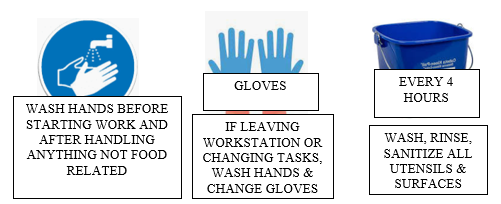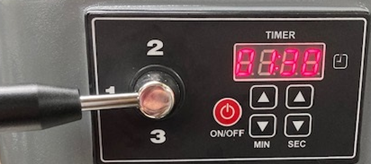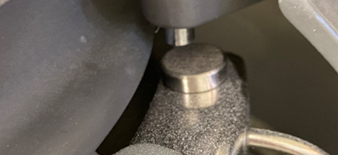Biscuit Baking with Biscuit Mixer
Quick Reference
Double Batch Recipe
- 64 ounces buttermilk
- 2 bags biscuit mix
| Product | Receiving | Storage | Cook Temp | Cook Time | Reheat Time | Hold Time | Quality Serving | Specifications |
|---|---|---|---|---|---|---|---|---|
| Biscuits | Dry Storage | Dry Storage | 375°F | 10 minutes | 4 minutes | 30 minutes - Display Cabinet Biscuit Warmer & Working Pans Expires End of Day - Biscuit Rack |
120°F | |
| Flour | Dry Storage | Dry Storage | ||||||
| Margarine | Cooler | Cooler | ||||||
| Buttermilk | Cooler | Cooler | ||||||
| Biscuit Standard | Weight: 2 1/4 to 2 1/2 ounces Size: 3 1/2 inches diameter 1 1/2 inches height |
Q.A. Standard: Round in diameter, free of cracks or splits, golden brown in color.
Tools Needed
- Electric mixer with bowl & hook
- Rolling pin with ½ inch height gauge
- 64-ounce measuring cup
- 13 ½” rubber spatula
- 6-inch-wide table scraper
- 3 ½ inch round biscuit cutter
- ½ size biscuit pans
- ¼ size biscuit pans
- Biscuit pan liners
- Pan holder
- 3” pastry brush
- Sifter
- (2) 1/6 size 4” deep pans for liquid margarine and self-rising flour
- Hanging oven thermometer
- 24” plastic wrap
Worksafe
- Wash and sanitize biscuit table surface and all tools before and after using
- Use caution when moving hot biscuit pans. Always use a pan holder.
Mixer Set Up
- Turn mixer on
- Ensure speed is to set to 1 – if not, adjust to 1
- Ensure timer is set to 1:30 – If not adjust to 1:30
- Place bowl onto mixer and securing by locking the sides
Mixing (Double Batch)
- Remove a carton of buttermilk from the cooler and shake well
- Measure 64 ounces of buttermilk into a measuring cup. Pour into mixing bowl.
- Empty 2–3-pound bags of biscuit mix into the mixer bowl
- Place dough hook into bowl
- Lock dough hook into position by sliding the hook into position and twisting
- Pull down on dough hook to ensure it is engaged
- Lock guard in place by turning and locking with magnet
- Use the handle arm on side to lift bowl into mixing position
- Press the start button on side
- After the mixer has completed the first 1:30 cycle, use a rubber spatula to scrape the sides and bottom of bowl
- After scraping, start the mixing process for another 1:30
- Once the mixing process is complete, remove dough from bowl
Rolling
- Using the sifter, heavily dust an area on the biscuit table with self-rising flour. The area should be slightly larger than the biscuit bowl. (Length of rolling pin)
- First batch of the day – Place approximately ¼ of the dough from the mixing bowl onto the center of the floured area.
- Scrape the sides and edges of the mixing bowl using a rubber spatula or scraper which will reduce build up in the bowl
- ON THE FIRST BATCH OF THE DAY, SIFT A HEAVY LAYER OF SELF-RISING FLOUR ON TOP OF THE DOUGH
- Gently press the dough down with your palms using overlapping hands until it is about 1 inch high
- Fold the left side into the middle
- Fold the right side into the middle
- Fold the top down to the middle
- Roll the top down to the bottom
- Gently pick up and hold the dough with one hand while smoothing out the floured area on the biscuit table with your fingertips
- It may be necessary to re-flour the work area to prevent the dough from sticking to the table until a base is built up
- Place folded ball of dough back onto the center of the floured area
- ANYTIME THERE IS NO REWORK IN THE DOUGH, REPEAT THE FOLDING STEPS
- Gently press the dough down with your palms using overlapping hands until it is about 1 inch high
- Before rolling, dust the rolling pin with flour away from dough
- Hold the rolling pin with your palms up. This will prevent you from pressing down too hard on the dough.
- Begin rolling the dough starting in the middle. Roll to the top and then to the bottom. Always roll to the end of the dough before changing directions.
- Continue to roll in a forward and backward motion until the dough is level and ½ inch thick. (This should take 6–8 complete passes.)
- If dough begins to build up in front of the pin, you are applying too much pressure. STOP! Lift the rolling pin, go to the end of the dough, and begin rolling in the opposite direction.
Cutting
- Flour the 3 ½ inch cutter by dipping it into the 1/6 size pan filled ½ full of self–rising flour
- Begin cutting out the biscuits in a honeycomb pattern starting at the top left corner of the dough sheet, moving left to right
- Press cutter through the dough in a straight up and down motion. Be careful not to twist the cutter. This will seal the biscuits and makes them difficult to open.
- Do not bend your wrist when cutting out biscuits. This will cause biscuits to rise higher on one side.
- Continue to cut biscuits in a honeycomb pattern, as close together as possible. This reduces the amount of re-work
- Re-flour the cutter every two biscuits to keep cutter from sticking to the biscuits
- Begin removing “ONLY” the outer portions of dough. Place it away from the work area. This will be your re-work dough. DO NOT PRESS OR WORK THIS DOUGH.
Panning
- Make sure pans are cool before placing biscuits on them
- Placing biscuits on warm pans will cause them to start rising before you are ready
- Place a pan liner on the biscuit pan
- Flour the tips of your fingers on both hands
- Using floured fingertips, walk your fingers under the biscuit
- Pick biscuits up from the table two at a time using both hands
- Be careful not to indent top or misshape biscuit
- If a biscuit sticks to the table, use biscuit scraper to lift it only if it can be removed without misshaping it. This is caused by dough being too wet or not spreading out flour thoroughly over work area.
- Begin placing biscuits on a lined pan filling the middle row first top to bottom. This will ensure correct spacing so biscuits will only have to be handled once.
- Fill in outside rows last
- When pan is full you should have 15 biscuits on the pan
- ANY BISCUIT THAT IS MISSHAPEN, INDENTED, OR THE TOP IS NOT SMOOTH SHOULD BE CULLED AND PLACED INTO THE RE-WORK PILE
Using Re–Work Dough
- Take the re-work dough from the previous batch and place it into the center of the next batch of fresh dough. Do not make re-work into a ball, this will cause re-work to become tough, and biscuits will be heavy.
- Gently press the re-work dough into the fresh. Press with your palms using overlapping hands as before until the dough is 1 inch high.
- Follow the procedures for rolling, cutting, and panning
- You should never have more re-work dough than fresh
Cooking and Reheating
- Biscuits should be cooked as soon as the pan/pans are full. This will prevent dough from rising too soon.
- Biscuit ovens should have three racks
- If only one pan is loaded, place it on the center rack
- If loading two pans, place one on the top rack and one on the bottom
- Check oven temperature
- Each oven should have an oven thermometer hanging from the top rack.
- When the red light goes out on the oven, check the thermometer. The temperature should be 375°.
- Do not load biscuits in the oven unless the red light is out, and oven is up to the correct temperature
- Rotate cooking of biscuits from oven to oven so that recovery time is minimized
- When the oven is at the correct temperature, open door and load pans
- Place pans toward the rear of the oven
- Close the door and set timer for 10 minutes for cooking or 4 minutes for reheating
- Do not open oven doors while biscuits are cooking
- When timer sounds, look through the glass door and make sure biscuits are golden brown in color (See Biscuit Chart)
- If biscuits are not the proper color, set timer for one minute until correct color is reached
- When timer sounds, open door and bring one pan out onto table. Close door. Check the tallest biscuit for doneness by lifting the top off and making sure it is fully cooked inside.
- If not done, place back in oven for one minute
- If biscuits are done, remove from oven using pan holder. Close oven door immediately so oven will recover to proper temperature quickly.
- Place biscuits on table and brush heavily with liquid margarine
- For consistency, always butter one row of 3 with each brush full of butter
- BISCUITS SHOULD BE BUTTERED ONCE WHEN COOKED, AND ONCE WHEN REHEATED. BISCUITS SHOULD BE BUTTERED TWICE IF THEY WILL BE PUT ON THE LINE WITHOUT BEING REHEATED.
Close of Breakfast
- Discard all leftover biscuit sandwiches
- Wash all biscuit pans
- Wash, Rinse, Sanitize and air-dry bowl and hook
- Use a sanitized towel to wipe down the exterior of mixer
- Set up biscuit table with utensils and biscuit mix for the next morning
Problem / Possible Cause
Biscuits are flat
- Incorrect oven temperature
- Dough too wet when rolled out
- Biscuits removed from oven before done
- Placing biscuits on a warm pan
- Dough rolled too thin
- Dough sits too long at room temperature before putting into oven
- Patting biscuit on pan
Biscuits burst open or have holes in tops
- Dough too wet when rolled out (Knead dough again if excess moisture is present on the dough during rolling)
Biscuits are misshapen
- Dough stretched when picking up
- Cutter slipped or twisted when cutting
- Using too much rework
- Over rolling dough
Biscuits are higher on one side
- Dough not rolled out level
- Cutter twisted sealing one side
- Biscuit pressed when placing on pan
- Biscuit came into contact with pan side
- Dough left in warm area causing biscuits to rise before cooking
- Bending wrist when cutting
Biscuits tough or Variations in height
- Overworking the dough
- Temperature too high
Doughy center
- Dough overworked
- Improper cooking time
- Improper cooking temperature
- Undercooked
Heavy biscuits (More than 2 1/2 ounces)
- Using too much rework dough
- Using too much dusting flour
- Over working the dough





